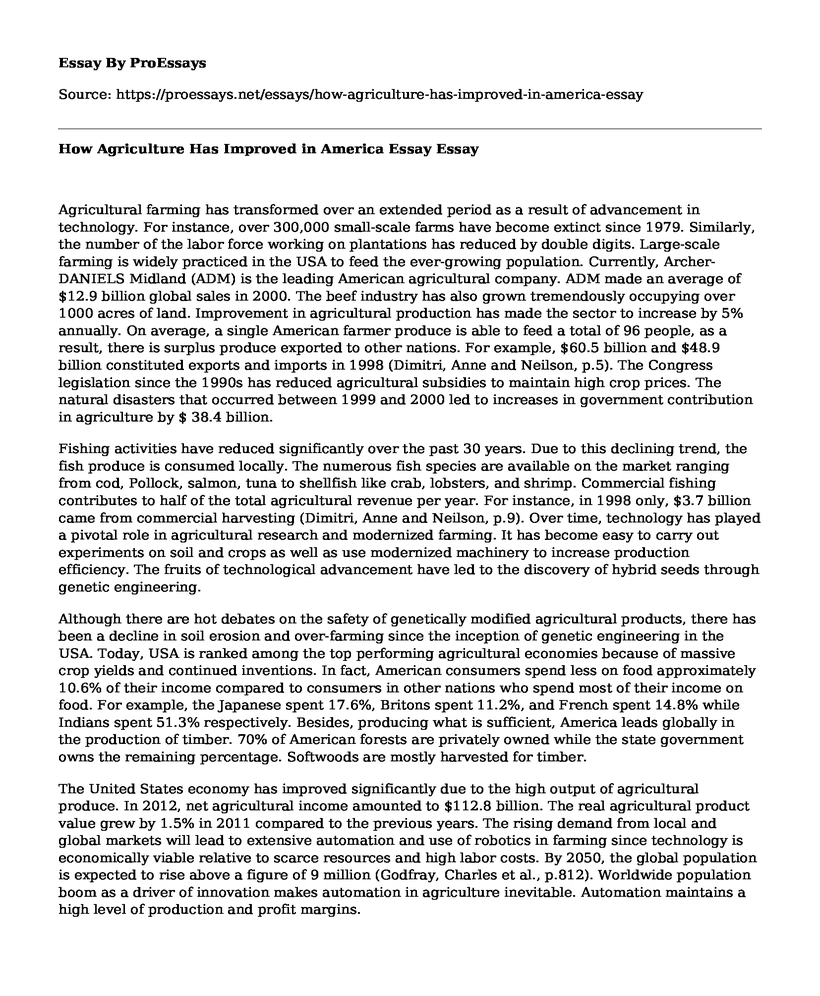Agricultural farming has transformed over an extended period as a result of advancement in technology. For instance, over 300,000 small-scale farms have become extinct since 1979. Similarly, the number of the labor force working on plantations has reduced by double digits. Large-scale farming is widely practiced in the USA to feed the ever-growing population. Currently, Archer-DANIELS Midland (ADM) is the leading American agricultural company. ADM made an average of $12.9 billion global sales in 2000. The beef industry has also grown tremendously occupying over 1000 acres of land. Improvement in agricultural production has made the sector to increase by 5% annually. On average, a single American farmer produce is able to feed a total of 96 people, as a result, there is surplus produce exported to other nations. For example, $60.5 billion and $48.9 billion constituted exports and imports in 1998 (Dimitri, Anne and Neilson, p.5). The Congress legislation since the 1990s has reduced agricultural subsidies to maintain high crop prices. The natural disasters that occurred between 1999 and 2000 led to increases in government contribution in agriculture by $ 38.4 billion.
Fishing activities have reduced significantly over the past 30 years. Due to this declining trend, the fish produce is consumed locally. The numerous fish species are available on the market ranging from cod, Pollock, salmon, tuna to shellfish like crab, lobsters, and shrimp. Commercial fishing contributes to half of the total agricultural revenue per year. For instance, in 1998 only, $3.7 billion came from commercial harvesting (Dimitri, Anne and Neilson, p.9). Over time, technology has played a pivotal role in agricultural research and modernized farming. It has become easy to carry out experiments on soil and crops as well as use modernized machinery to increase production efficiency. The fruits of technological advancement have led to the discovery of hybrid seeds through genetic engineering.
Although there are hot debates on the safety of genetically modified agricultural products, there has been a decline in soil erosion and over-farming since the inception of genetic engineering in the USA. Today, USA is ranked among the top performing agricultural economies because of massive crop yields and continued inventions. In fact, American consumers spend less on food approximately 10.6% of their income compared to consumers in other nations who spend most of their income on food. For example, the Japanese spent 17.6%, Britons spent 11.2%, and French spent 14.8% while Indians spent 51.3% respectively. Besides, producing what is sufficient, America leads globally in the production of timber. 70% of American forests are privately owned while the state government owns the remaining percentage. Softwoods are mostly harvested for timber.
The United States economy has improved significantly due to the high output of agricultural produce. In 2012, net agricultural income amounted to $112.8 billion. The real agricultural product value grew by 1.5% in 2011 compared to the previous years. The rising demand from local and global markets will lead to extensive automation and use of robotics in farming since technology is economically viable relative to scarce resources and high labor costs. By 2050, the global population is expected to rise above a figure of 9 million (Godfray, Charles et al., p.812). Worldwide population boom as a driver of innovation makes automation in agriculture inevitable. Automation maintains a high level of production and profit margins.
Conclusion
It is undoubtedly that the USA agricultural sector has positively improved since the 19th century to meet the high demand locally and international. Apart from satisfying consumer demand, the agricultural sector has also contributed significantly to national revenue generation as well as employment opportunities. For purposes of cutting on the agricultural costs, the farmers should adopt modernized farming techniques; the government should regulate genetic engineering activities and provide subsidies for farmers. More so, from the American agricultural advancement, it implies that technology is taking center stage in agricultural production.
Works Cited
Dimitri, Carolyn, Anne Effland, and Neilson Conklin. "The 20th Century Transformation of US Agriculture and Farm Policy. USDA, ERS, Economic Information Bulletin No. 3." (2005).
Godfray, H. Charles J., et al. "Food security: the challenge of feeding 9 billion people." science 327.5967 (2010): 812-818.
Cite this page
How Agriculture Has Improved in America Essay. (2022, Mar 29). Retrieved from https://proessays.net/essays/how-agriculture-has-improved-in-america-essay
If you are the original author of this essay and no longer wish to have it published on the ProEssays website, please click below to request its removal:
- Essay Sample: Impact of Information Technology on the Financial Market
- Determining the Price of Diamonds: Supply and Demand Analysis
- Essay Example on Performance-Based Budgeting
- Compare and Contrast Essay on Fixed and Floating Exchange Rate Systems
- COVID-19: Showing Social Safety Net's Weaknesses & Low-Wage Worker Struggles - Essay Sample
- Essay Example on Unions' Strikes: A Visual Journey
- Paper Example on CHRO Establishes Strategic Recruitment Plan for Expansion







